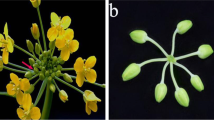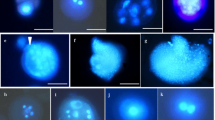Abstract
The effects of three periods of incubation (10, 20 and 30 min) at different levels of bleomycin (0, 0.1, 0.2, 0.3, 0.4 and 0.5 μg ml−1), as well as three periods of exposure (12, 24 and 48 h) to different levels of the anti-auxin p-chlorophenoxyisobutyric acid (PCIB), including 1, 2, 3, 4 and 5 mg l−1, on microspore embryogenesis of rapeseed cv. ‘Amica’ were investigated. Microspore embryogenesis was significantly enhanced following 20 min treatment with 0.2 μg ml−1 bleomycin compared with untreated cultures. Highest embryo yield (163 embryos Petri dish−1) was observed with 24 h treatment of 4 mg l−1 PCIB. The highest percentage of secondary embryogenesis was observed on B5 medium containing 0.15 mg l−1 of gibberellic acid (GA3) and 0.2 mg l−1 6-benzyladenine (BA) in 4–6 mm microspore-derived embryos (MDEs). Most callus formed on B5 medium containing 0.15 mg l−1 GA3, 0.1 mg l−1 BA and 0.1 mg l−1 indole-3-acetic acid (IAA) when 4–6 mm embryos were used. Regeneration was highest on B5 medium containing 0.05 mg l−1 GA3 or 0.1 mg l−1 BA and 0.2 mg l−1 IAA with 2–4 mm embryos. Microspore embryogenesis and plant regeneration could be improved by both bleomycin and PCIB when the appropriate MDE length and phytohormone level were selected.



Similar content being viewed by others
Abbreviations
- PCIB:
-
p-Chlorophenoxyisobutyric acid
- GA3 :
-
Gibberellic acid
- BA:
-
6-Benzyladenine
- IAA:
-
Indole-3-acetic acid
- MDE:
-
Microspore-derived embryo
- DH:
-
Doubled haploid
- PGR:
-
Plant growth regulator
- HSP:
-
Heat shock protein
- ZE:
-
Zygotic embryo
- QTL:
-
Quantitative trait locus
References
Abraha E, Bechyne M, Klima M, Vyvadilova M (2008) Analysis of factors affecting embryogenesis in microspore cultures of Brassica carinata. Agric Trop Subtrop 41:53–60
Agarwal PK, Agarwal P, Custers JBM, Liu CM, Bhojwani SS (2006) PCIB an antiauxin enhances microspore embryogenesis in microspore culture of Brassica juncea. Plant Cell Tissue Org Cult 86:201–210
Ahmad I, Day JP, MacDonald M, Ingram DS (1991) Haploid culture and UV mutagenesis in rapid-cycling Brassica napus for the generation of resistance to chlorsulfuron and Alternaria brassicicola. Ann Bot 67:521–525
Aslam FN, MacDonald MV, Loudon PT, Ingram DS (1990) Rapid-cycling Brassica species: inbreeding and selection of Brassica napus for anther culture ability and an assessment of its potential for microspore culture. Ann Bot 66:331–339
Babbar SB, Agarwal PK, Sahay S, Bhojwani SS (2004) Isolated microspore culture of Brassica: an experimental tool for developmental studies and crop improvement. Indian J Biotech 3:185–202
Baillie AMR, Epp DJ, Hutcheson D, Keller WA (1992) In vitro culture of isolated microspores and regeneration of plants in Brassica campestris. Plant Cell Rep 11:234–237
Bhowmik P, Dirpaul J, Polowick P, Ferrie AMR (2011) A high throughput Brassica napus microspore culture system: influence of percoll gradient separation and bud selection on embryogenesis. Plant Cell Tissue Org Cult 106:359–362
Burnett L, Yarrow S, Huang B (1992) Embryogenesis and plant regeneration from isolated microspores of Brassica rapa L. ssp. Oleifera. Plant Cell Rep 11:215–218
Choung PV, Beversdorf WD (1985) High frequency embryogenesis through isolated microspore culture in Brassica napus and B. carinata Braun. Plant Sci 39:219–226
Cordewener JHG, Hause G, Gorgen E, Busink R, Hause B, Dons HJM, Van Lammeren AAM, Van Lookeren Campagne MM, Pechan P (1995) Changes in synthesis and localization of members of the 70-kDa class of heat-shock proteins accompany the induction of embryogenesis in Brassica napus L. microspores. Planta 196:747–755
Coventry J, Kott LS (1998) Double haploid technology for spring and winter Brassica napus (revised ed.). OAC Publication, University of Guelph, Ontario, Canada. Technol Bull p 42
Eyasu A, Bechyne M, Klima M, Vyvadilova M (2007) Embryogenesis responsibility of selected genotypes of Brassica carinata A. Braun to microspore culture. Agric Trop Subtrop 40(2):35–38
Feher A, Pasternak TP, Dudits D (2003) Transition of somatic plant cells to an embryogenic state. Plant Cell Tissue Org Cult 74:201–228
Ferrie AMR, Caswell KL (2011) Isolated microspore culture techniques and recent progress for haploid and doubled haploid plant production. Plant Cell Tissue Org Cult 104:301–309
Ferrie AMR, Keller WA (2007) Optimization of methods for using polyethylene glycol as non-permeating osmoticum for the induction of microspore embryogenesis in the Brassicacea. In Vitro Cell Dev Biol Plant 43:348–355
Ferrie AMR, Taylor DC, MacKenzie SL, Keller WA (1999) Microspore embryogenesis of high sn-2 erucic acid Brassica oleracea germplasm. Plant Cell Tissue Organ Cult 57:79–84
Forster BP, Heberle-Bors E, Kasha KJ, Touraev A (2007) The resurgence of haploids in higher plants. Trends Plant Sci 12:368–375
Gland A, Lichter R, Schweiger HG (1988) Genetic and exogenous factors affecting embryogenesis in isolated microspore culture of Brassica napus L. J Plant Physiol 132:613–617
Gu HH, Zhang DQ, Zhou WJ (2004) Effect of medium renovation and colchicine treatment on embryogenesis of isolated microspores of Brassica rapa spp. chinensis. Acta Agron Sin 30:78–81
Haddadi P, Moieni A, Karimzadeh G, Abdollahi MR (2008) Effects of gibberellin, abscisic acid and embryo desiccation on normal plantlet regeneration, secondary embryogenesis and callogenesis in microspore of Brassica napus L. cv. PF704. Int J Plant Prod 2(2):153–162
Hadfi K, Speth V, Neuhaus G (1998) Auxin-induced developmental patterns in Brassica juncea embryos. Development 125:879–887
Hays DB, Mandel RM, Pharis RP (2001) Hormones in zygotic and microspore embryos of Brassica napus. Plant Growth Reg 35:47–58
Jeung HW, Lee SS (1997) Influence of NMU on embryo induction and plant development of microspore culture in broccoli. J Korean Soc Hortic Sci 38:379–383
Keller WA, Armstrong KC (1979) Stimulation of embryogenesis and haploid production in Brassica campestris anther cultures by elevated temperature treatments. Theor Appl Genet 55:65–67
Klima M, Vyvadilova M, Kucera V (2004) Production and utilization of doubled haploids in Brassica oleracea vegetables. Hortic Sci 31:119–123
Klima M, Vyvadilova M, Kucera V (2008) Chromosome doubling effects of selected antimitotic agents in Brassica napus microspore culture. Czech J Plant Breed 44(1):30–36
Kott L, Beversdorf WD (1990) Enhanced plant regeneration from microspore-derived embryos of Brassica napus by chilling, partial desiccation and age selection. Plant Cell Tissue Org Cult 23:187–192
Krzyzanowska D, Gorecka K (2008) Effect of various stress factors on the induction of androgenesis in anther cultures of Brussels sprouts (Brassica oleracea L. var. Gemmifera). Veg Crop Res Bull 69:5–13
Lewis TG, Nydorf ED (2006) Intralesional bleomycin for warts: a review. J Drug Dermatol 5:499–504
Lichter R (1982) Induction of haploid plants from isolated pollen of Brassica napus. Z Pflanzenphysiol 105:427–434
Lo KH, Pauls KP (1992) Plant growth environment effects on rapeseed microspore development and culture. Plant Physiol 99:468–472
MacRae DH, Bonner J (1953) Chemical structure and antiauxin activity. Physiol Plant 6:485–510
Menke M, Chen IP, Angelis KJ, Schubert I (2001) DNA damage and repair in Arabidopsis thaliana as measured by the comet assay after treatment with different classes of genotoxins. Mutat Res 493:87–93
Pechan PM, Keller WA (1989) Induction of microspore embryogenesis in Brassica napus by gamma irradiation and ethanol stress. In Vitro Cell Dev Biol Plant 25:1073–1075
Pechan PM, Bartels D, Brown DCW, Schell J (1991) Messenger-RNA and protein changes associated with induction of Brassica napus embryogenesis. Planta 184:161–165
Prem D, Gupta K, Agnihotri A (2005) Effect of various exogenous and endogenous factors on microspore embryogenesis in Indian mustard (Brassica juncea L. Czern and Coss). In Vitro Cell Dev Biol Plant 41:266–273
Ramesar-Fortner NS, Yeung EC (2006) Physiological influences in the development and function of the shoot apical meristem of microspore-derived embryos of Brassica napus “Topas”. Can J Bot Rev 84:371–383
Sato S, Katoh N, Iwai S, Hagimori M (2002) Effect of low temperature pretreatment of bud or inflorescence on isolated microspore culture in Brassica rapa (syn. B. campestris). Breed Sci 52:23–26
Seguí-Simarro JM, Nuez F (2008) How microspores transform into haploid embryos: changes associated with embryogenesis induction and microspore-derived embryogenesis. Physiol Plant 134:1–12
Seibel J, Pauls KP (1989) A comparison of anther and microspore culture as a breeding tool in Brassica napus. Theor Appl Genet 78:473–479
Sonntag K, Rodloff E (2004) Microspore mutagenesis in transgenic oilseed rape for the modification of fatty-acid composition. Acta Universitatis Latviensis Biol 676:227–230
Swanson EB, Erickson LR (1989) Haploid transformation in Brassica napus using an octopine-producing strain of Agrobacterium tumefaciens. Theor Appl Genet 78:831–835
Swanson EB, Coumans MP, Wu SC, Barsby TL, Beversdorf WD (1987) Efficient isolation of microspores and the production of microspore-derived embryos from Brassica napus. Plant Cell Rep 6:94–97
Tang GX, Zhou WJ, Li HZ, Mao BZ, He ZH, Yoneyama K (2003) Medium, explant and genotype factors influencing shoot regeneration in oilseed Brassica spp. J Agron Crop Sci 189:351–358
Tian H, Yao CY, Sun MX (2004) High frequency conversion of microspore-derived embryos of Brassica napus cv. Topas by supplemental calcium and vitamins. Plant Cell Tissue Org Cult 76:159–165
Wang T, Li H, Zhang J, Ouyang B, Lu Y, Ye Z (2009) Initiation and development of microspore embryogenesis in recalcitrant purple flowering stalk (Brassica campestris ssp. chinensis var. purpurea Hotr.) genotypes. Sci Hortic 121:419–424
Winarto B, Teixeira da Siva JA (2011) Microspore culture protocol for Indonesian Brassica oleracea. Plant Cell Tissue Org Cult 107:305–315
Xie Q, Frugis G, Colgan D, Chua NH (2000) Arabidopsis NAC1 transduced auxin signal downstream of TIR1 to promote lateral root development. Genes Dev 14:3024–3036
Yu FQ, Liu HL (1995) Effect of donor materials and medium on microspore embryoids of Brassica napus. J Hauzhong Agric Univers 14:327–332
Zaki MAM, Dickinson HG (1991) Microspore-derived embryos in Brassica: the significance of division symmetry in pollen mitosis I to embryogenic development. Sex Plant Reprod 4:48–55
Zarsky V, Garrido D, Eller N, Tupy J, Vicente O, Schofl F, Heberle-Bors E (1995) The expression of small heat shock gene is activated during induction of tobacco pollen embryogenesis by starvation. Plant Cell Environ 18:139–147
Zeng X, Wen J, Wan Z, Yi B, Shen J, Ma C, Tu J, Fu T (2010) Effect of bleomycin on microspore embryogenesis in Brassica napus and detection of somaclonal variation using AFLP molecular marker. Plant Cell Tissue Org Cult 110:23–29
Zhang GQ, Zhang DQ, Tang GX, He Y, Zhou WJ (2006) Development from microspore-derived embryos in oilseed rape as affected by chilling, desiccation and cotyledon excision. Biol Plant 150:180–186
Zhang W, Qiang F, Xigang D, Manzhu B (2008) The culture of isolated microspores of ornamental kale (Brassica oleracea var. acephala) and the importance of genotype to embryo regeneration. Sci Hortic 117:69–72
Zhang H, Jin T, Zhang G, Chen L, Zou W, Li QQ (2011) Polymorphisms in heat-shock protein 70 genes are associated with coal workers’ pneumoconiosis in southwestern China. In Vivo 25(2):251–257
Zhou WJ, Tang GX, Hagberg P (2002) Efficient production of doubled haploid plants by immediate colchicine treatment of isolated microspores in winter Brassica napus. Plant Growth Reg 37:185–192
Author information
Authors and Affiliations
Corresponding author
Rights and permissions
About this article
Cite this article
Ahmadi, B., Alizadeh, K. & Teixeira da Silva, J.A. Enhanced regeneration of haploid plantlets from microspores of Brassica napus L. using bleomycin, PCIB, and phytohormones. Plant Cell Tiss Organ Cult 109, 525–533 (2012). https://doi.org/10.1007/s11240-012-0119-8
Received:
Accepted:
Published:
Issue Date:
DOI: https://doi.org/10.1007/s11240-012-0119-8




